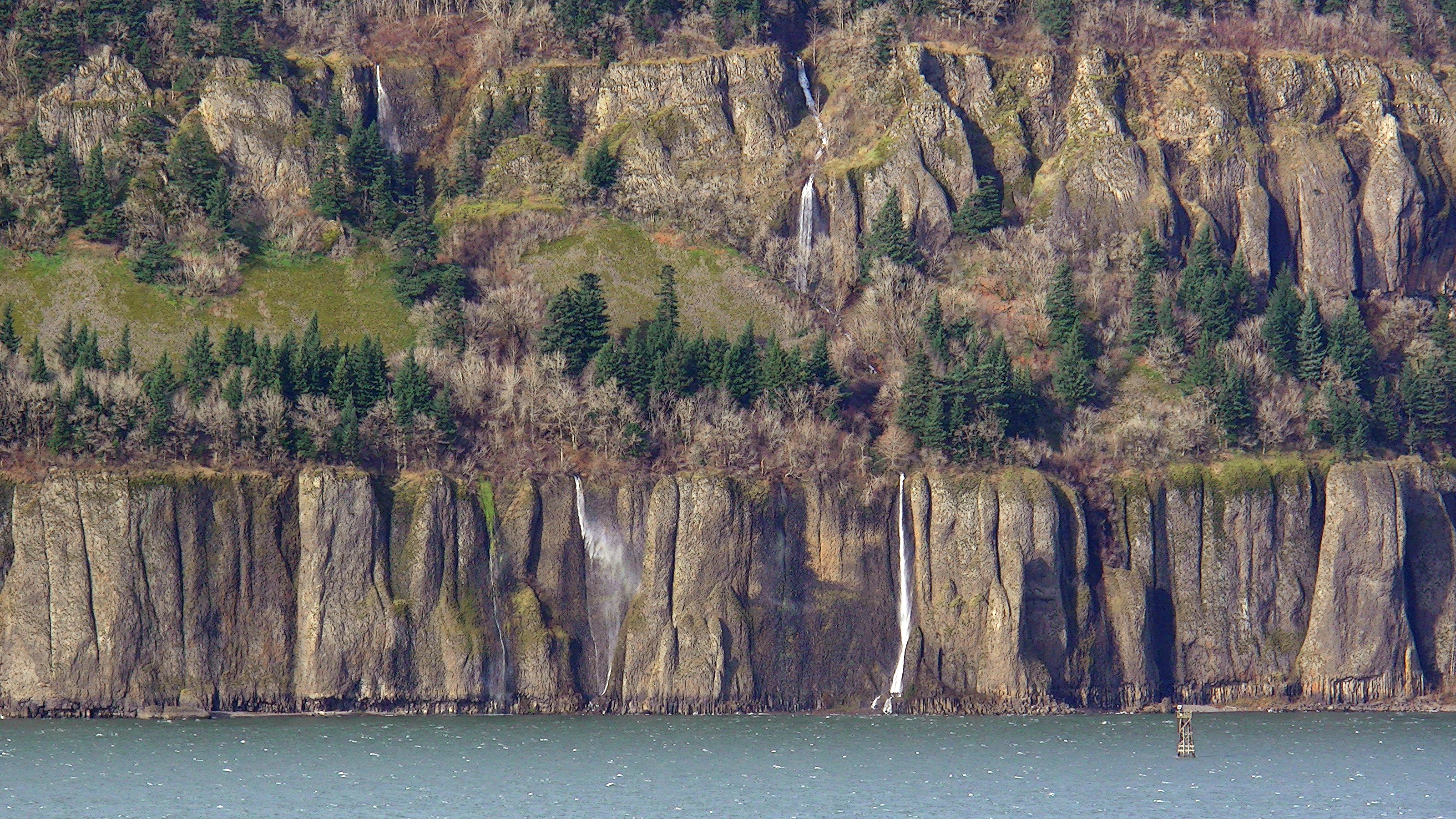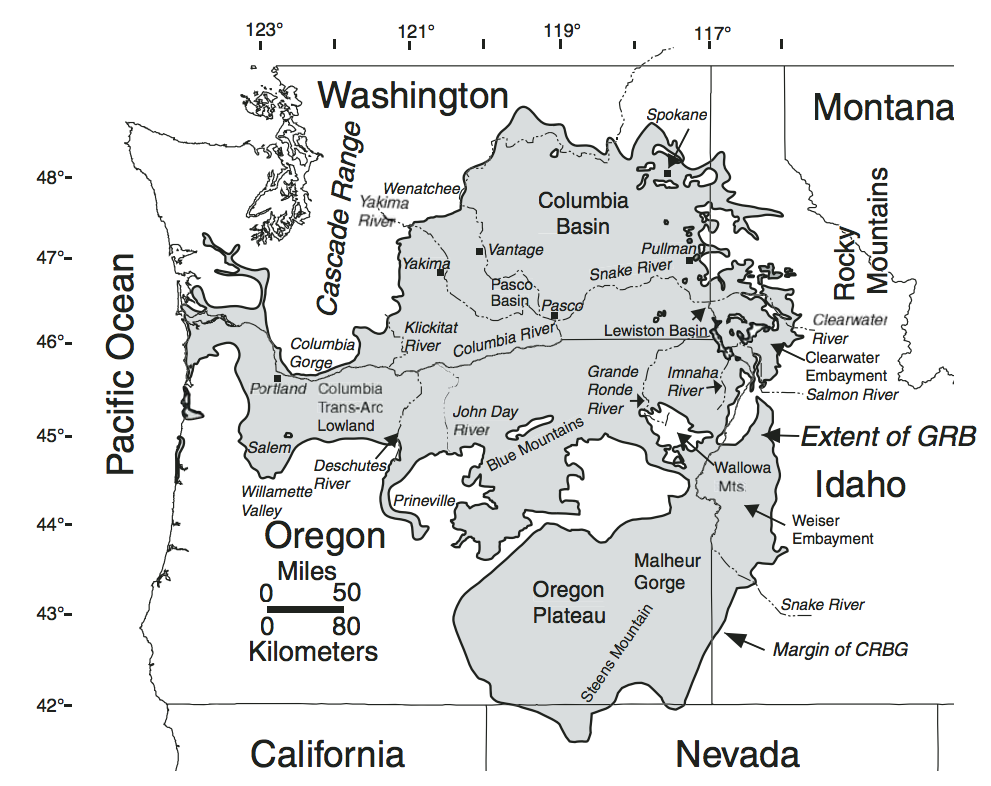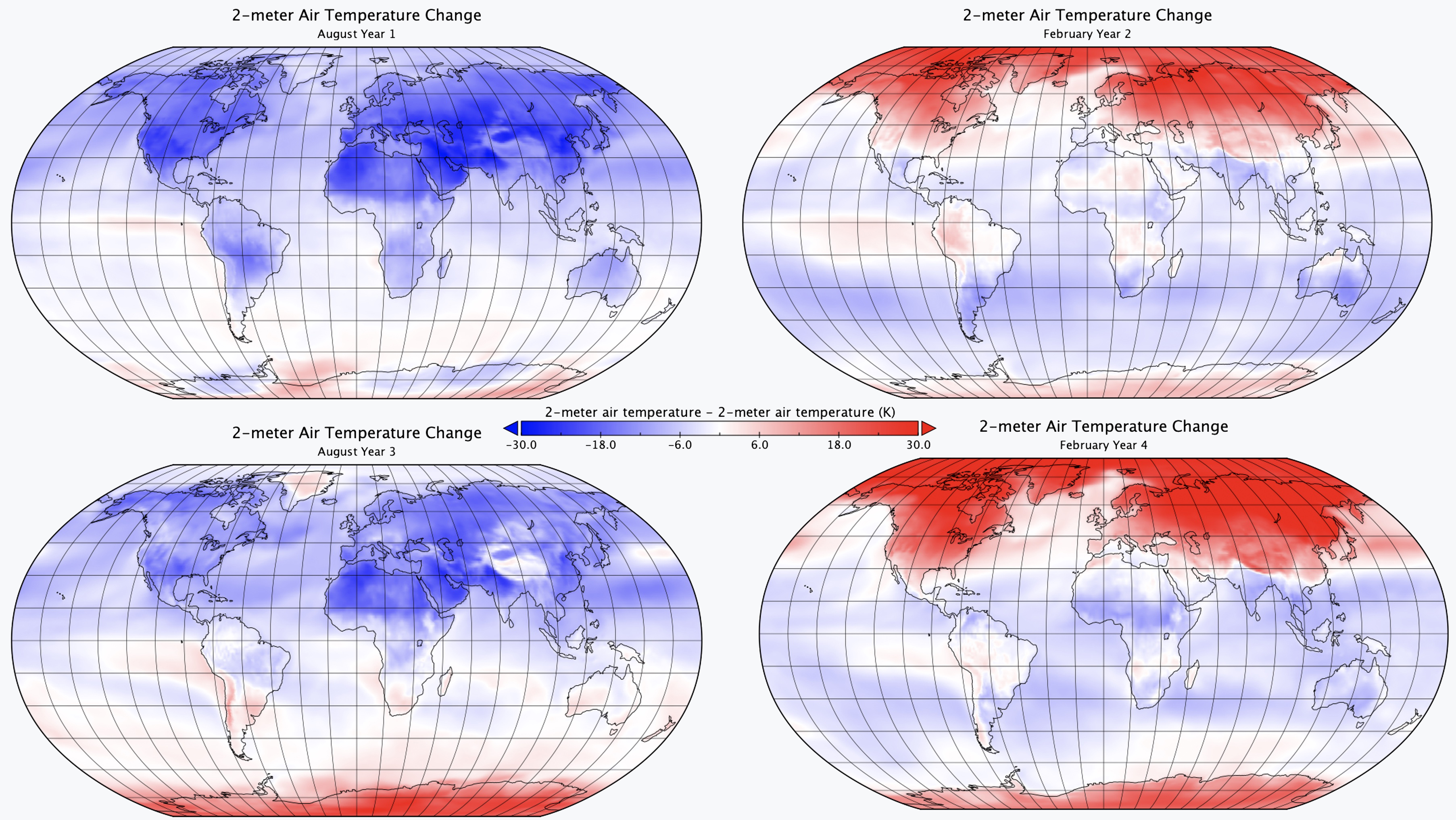NCCS-Enabled Simulations of Massive Ancient Volcanic Eruption
Show Unexpected Climate Warming

This photograph shows waterfalls flowing from basalt outcrops along the Columbia River in Oregon. Gigantic volcanic eruptions 15 to 17 million years ago deposited basalt layers like these across a vast region known as the Columbia River Basalt Group. Photo by Steven Sobieszczyk, U.S. Geological Society.
In an interdisciplinary collaboration, NASA Goddard Space Flight Center planetary and Earth scientists leveraged the Goddard Earth Observing System Chemistry-Climate Model (GEOSCCM) and the NASA Center for Climate Simulation (NCCS) to simulate an ancient, massive volcanic eruption in the Columbia River Basalt Group region of the U.S. Pacific Northwest.
This eruption — the largest simulated with GEOSCCM to date — explored a 4-year phase of a flood basalt volcanic eruption and its aftermath, occurring 15 to 17 million years ago in eastern Washington and Oregon. A series of such long-duration eruptions ultimately deposited basalt rock across 210,000 square kilometers (81,000 square miles) of land.

This map of the Columbia River Basalt Group shows the main regions of basalt exposure during ancient volcanic eruptions in Washington, Oregon, Idaho, and Nevada, USA. Map by U.S. Geological Society.
The study was an effort of NASA Goddard’s Sellers Exoplanet Environments Collaboration (SEEC) and involved nine researchers from the Planetary Environments Laboratory; Planetary Geology, Geophysics, and Geochemistry Laboratory; and Planetary Systems Laboratory in the Solar System Exploration Division and the Atmospheric Chemistry and Dynamics Laboratory in the Earth Sciences Division. The study team includes computational scientists and field volcanologists.

Study co-authors were (top and bottom, left to right) Scott Guzewich, Planetary Environments Laboratory; Luke Oman, Atmospheric Chemistry and Dynamics Laboratory; Jacob Richardson, Patrick Whelley, Sandra Bastelberger (not shown), Kelsey Young, and Jacob Bleacher, Planetary Geology, Geophysics and Geochemistry Laboratory; Thomas Fauchez, Planetary Systems Laboratory; and Ravi Kopparapu, Planetary Environments Laboratory.
“The project is funded by SEEC, so we did the work with an eye toward planetary and exoplanetary implications and interpretations,” said lead author Scott Guzewich, Associate Lab Chief of NASA Goddard’s Planetary Environments Laboratory. Observations show that similar flood basalt volcanic eruptions likely occurred on Venus and Mars in the distant past and may have drastically altered the planets’ climates.
“Unfortunately, many of the planetary/exoplanetary climate models are not sophisticated enough to do such a simulation,” Guzewich said. “So, we employed GEOSCCM and focused on an Earth archetype for the first phase of this project.”


Two study team members are field volcanologists whose research complements and informs the simulation studies. In the last few years, Patrick Whelley (top) traveled to Alaska to study the effects of the largest volcanic eruption of the 20th century, 1912’s Novarupta eruption, and Jacob Richardson (left) traveled to the Big Island of Hawai’i to study the Kīlauea Volcano, which erupted almost continuously from 1983 to 2018.
For this study, the researchers ran GEOSCCM at approximately 100-kilometer resolution in both atmosphere and ocean. The NCCS Discover supercomputer enabled two 20-year GEOSCCM simulations, each using 680 processor cores for about 50 days. More than 2 terabytes of output data reside in NCCS mass storage.
The first simulation served as a baseline, while the second simulation pumped 30 gigatons of sulfur dioxide into Earth’s atmosphere — about 1,500 times the quantity of sulfur dioxide released by the 1991 volcanic eruption of Mount Pinatubo in the Philippines. “We focused on sulfur dioxide, and not on any of the other plausible components of a volcanic plume, to see how the climate would respond to such a large and long-duration eruption,” Guzewich said. “Combining the massive volcanic eruption with the sophisticated physics of GEOSCCM led to some unique results.”

A cloud of volcanic ash and gas rises above Mount Pinatubo, Philippines, on June 12, 1991. Three days later, the volcano exploded in the second largest volcanic eruption on Earth in the 20th century. The NASA-simulated volcano released about 1,500 times as much sulfur dioxide into the atmosphere as the Pinatubo eruption. Photo by Dave Harlow, U.S. Geological Society.
Based on the response from modern volcanic eruptions, the scientists were expecting the large emission of sulfur dioxide to produce intense climate cooling. For example, the Pinatubo eruption led to roughly 1° Fahrenheit of cooling for 1–2 years due to reflective sulfate aerosols forming in the stratosphere.
“While the climate did briefly cool in our simulations, it was then overwhelmed by intense climate warming,” Guzewich said. “After some study, we determined this was due to a secondary effect of the eruption: a thousand-fold increase in stratospheric water vapor, which acted as a greenhouse warming agent. This was very surprising and unexpected.”

The world maps show summer cooling and winter warming after a simulated massive volcanic eruption in the Columbia River Basalt Group, with the color scale indicating changes in monthly mean 2-meter air temperature (in degrees Kelvin) for key summer and winter months during the simulation: (top left) August in simulation Year 1; (top right) February in Year 2; (lower left) August in Year 3; and (lower right) February in Year 4. Visualization by Luke Oman, NASA Goddard Space Flight Center, and from Supporting Information for Guzewich et al., 2022. View full-resolution image.
This outcome implies that the long duration of flood basalt eruptions drives unique climate responses that do not occur from classic stratovolcano eruptions such as Pinatubo. In the NASA simulation, sulfate aerosols being removed faster than water vapor from the stratosphere allows the water vapor’s warming effect to dominate. Such results challenge the volcano research community’s prevailing “volcanic winter” paradigm of long-duration cold and darkness after massive flood basalt eruptions, the scientists noted.
At NCCS, the NASA researchers are currently running additional large volcano simulations exploring the threshold in sulfur dioxide volume that triggers this climate response while also adding carbon dioxide emissions. Volcanic carbon dioxide emissions are believed to have caused warm climate periods throughout Earth’s history, and these new simulations will help scientists understand the combined response of carbon dioxide and sulfur dioxide in volcanic eruptions like Columbia River.
“Conducting such computationally expensive simulations would not be possible without NCCS’s resources,” Guzewich said.
Related Link
- Guzewich, S.D., L.D. Oman, J.A. Richardson, P.L. Whelley, S.T. Bastelberger, K.E. Young, J.E. Bleacher, T.J. Fauchez, and R.K. Kopparapu, 2022: Volcanic Climate Warming Through Radiative and Dynamical Feedbacks of SO2 Emissions. Geophysical Research Letters, 49, e2021GL096612, doi:10.1029/2021GL096612.
- “NASA Simulation Suggests Some Volcanoes Might Warm Climate, Destroy Ozone Layer,” NASA Web Feature, 5/2/22.
Jarrett Cohen, NASA Goddard Space Flight Center
July 22, 2022


